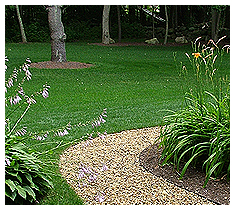St. Augustine Grass in California
A robust, fast-growing, warm season grass
A warm season grass which offers a medium green color with a coarse, thickstemmed leaf and texture and a creeping growth habit via stolons. Robust, fast-growing, establishes rapidly. Very shade tolerant and may go dormant in the winter.
General Rating
- Drought Tolerance
- Disease Resistance
- Wear Resistance
- Shade Tolerance
- Winter Color
- Heat Tolerance
Available at these farms
Maintenance Guide
Technical Data
Technical Data |
|
|
Common Name |
St. Augustine |
|
Species |
Stenotaphrum Secundatum |
|
Root Depth |
1 to 3 feet, depending upon soil type and watering patterns. |
Adaptability |
|
|
Soils Range |
Fair tolerance to saline soil conditions. |
|
Temperature Tolerance |
20°F. to 120°F. |
|
ET0 |
.5 minimum, .7 preferred |
|
pH Range |
5.0 to 8.5, 7.0 optimum |
|
Shade Tolerance |
Prefers full sun, but tolerates 60% shade. |
|
Geographic Range |
(Refer to temperature tolerance above.) |
Standards and Measures |
|
|
Size |
Piece varies by market |
|
Big Rolls |
200 to 500 sq. ft. |
|
Soil Thickness |
1/2 inch, + top growth |
|
Weight |
2,500 to 3,000 lbs. per pallet |
|
Other |
– 100% Weed Free Sod |
Ready to order? Have a few questions?
Contact the farm nearest you.
Moreno Valley, CA
800-233-5254
Palmdale, CA
800-669-4763
Fresno, CA
888-800-8483
Stockton, CA
800-588-6882
Fort Collins, CO
970-482-6574
